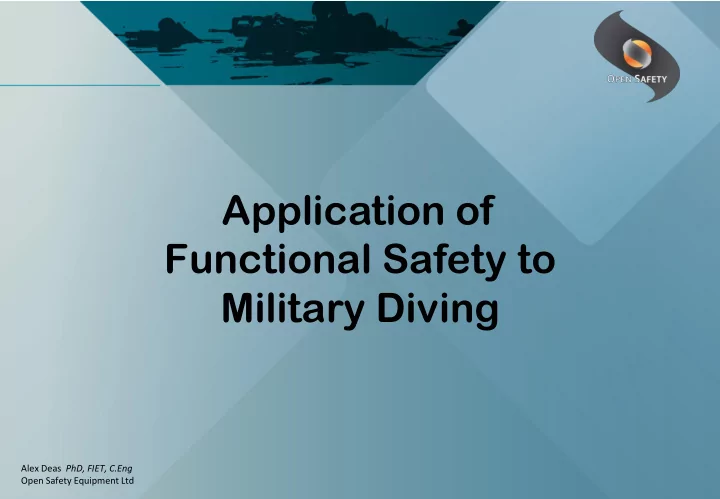

Application of Functional Safety to Military Diving Alex Deas PhD, FIET, C.Eng Open Safety Equipment Ltd
Slide 2
Credentials Open Safety are the only company in the whole of the dive industry to have been certified to a recognised functional safety standard. We specialise in respiratory systems: rebreathers, full face masks, gas protection. Open Safety have been shipping rebreathers in volume worldwide since 2009, with zero safety mishaps. Open Safety have four models of rebreather CE certified, and two other models have corresponding national certifications outside the EU, in volume production. Open Safety work with Apollo Military, Northern Diver, and other Tier 1 suppliers who provide a “one - stop shop” covering everything needed for tactical diving. Your speaker: 44 years in safety engineering, from science apprenticeship at Harwell Laboratory (Europe's foremost nuclear laboratory), through to PhD, led the microelectronics section at Harwell, Fellow of the Institute of Engineering and Technology. Lead in Functional Safety. Diving since 1979, expedition diver (100m+ certified on SCUBA), dive tech, O2 tech. CEO of Open Safety. Slide 3
Key Aspects of Functional Safety 1. Understanding hazards: HAZOPs, Accident Studies, FMECA 2. Requirement for Formal Modeling 3. Formal Proof that Equipment is Correct and does not have unknown failure modes 4. Whole lifecycle management 5. ALARP: Risk mitigated to be As Low As Reasonably Possible 6. Independent Assessment Slide 4
Functional Safety Benefits 1. Lifetime warranties 2. Lifetime safety or performance upgrades, without charge 3. No surprises: it is surprising how many there are in dive equipment 4. Open disclosure i.e. all things users want but suppliers resist doing At the higher Functional Safety levels, there is no option except to deliver these. Slide 5
Why? Answer: ALARP Reduce the risk to As Low As Reasonably Practicable Lifecycle from concept to final disposal → responsibility does not finish with shipment End to End: includes operator & connection to ancillary equipment If a part has a manufacturing defect, it cannot remain in use → lifetime warranty If the manufacturer is aware of a means to improve the safety, then it must be provided → lifetime safety upgrades without charge A charge is an impediment to adoption of a safety improvement → not acceptable Slide 6
Safety Integrity Levels SIL Level PDF per hour Applied where risk of Examples 0 Any number No injury or fatality Table 1 1 in a million Injury Medical shower 2 1 in 10 million Fatalities < 20 Aircraft 3 1 in 100 million More than 20 fatalities Mass produced RBs 4 1 in a billion Mass fatalities Nuclear Reactors PDF: Probability of Dangerous Failure This table is for equipment that has to operate to provide safety, e.g. rebreathers. Alarms and monitors that activate only rarely are allowed 10,000 times more failures for the same SIL Slide 7
Example: O2-SCR Switches In O2 mode, if Nitrox leaks in, result is hypoxia Slide 8
Non-FS vs FS: gas switches Rebreather O2 – SCR switch in use in European Navies, Rebreather O2 – SCR switch in use in Asian Navies, one o-ring from disaster (no redundancy) triple redundancy (quad redundant in use) dual technology Slide 9
Other Rebreather Examples Risk Typical Performance SIL 3 Performance Flood Caustic cocktail Fully flood recoverable. Diveable flooded. Hypercapnia → O2 2.2 J/L to 5J/L WOB 1.4J/L WOB seizure Real deadspace up to 1L Real deadspace <0.2L Mission risk Prebreathe, slowly Instant on, max RMV Weight ready to dive Up to 34kg <6kg, <11kg, <18kg Field Maintenance Tools No tools Materials POM (Delrin), Rubbers ASA, TPU: non offgasing, safe, strong PPO2 readings Some rec RBs have many Free of serious defect, zero fatalities from water block, mishaps in any market sector hanging etc Slide 10
Lithium Batteries ATEX & IEC Ex batteries, 33% lower capacity for same size For Functional Safety, all failure modes must be assessed → Floodable. → Crushable without temperature overrun or flame. → Pierce without temperature overrun or flame. Achieved using both LiFePo and LiMn chemistries, BUT at the cost of capacity 33% lower capacity, means: 50% increase in performance per watt required for device, or 50% bigger battery Important in diver propulsion, navigation, rebreathers Slide 11
Specifying FS in contracting 1. Insisting on audited IEC EN 61508 for all electronics & software 2. Insist on EN 61508 or equivalent for mechanics using end to end scope as basis 3. Be aware, response of dive industry was to remove FS from EN 14143 in 2013 revision 4. Specify lifetime warranty 5. Specify lifetime safety upgrades: it can be done Slide 12
Specifying FS in contracting 1. Insisting on audited IEC EN 61508 SIL 2 or SIL 3 for all electronics & software 2. Insist on EN 61508 or equivalent for mechanics using end to end scope as basis 3. Be aware, response of dive industry was to remove FS from EN 14143 in 2013 revision 4. Specify lifetime warranty: if it is a Functional Safe system, then it is your right 5. Specify lifetime safety upgrades: it can be done Slide 13
Summary Functional Safety can: 1. Eliminate hidden equipment risks 2. Keep equipment up to date with best available performance and technology 3. Provide lifetime warranties 4. Improve performance of equipment as supplier wishes to avoid risk from above It is easily specified in dive equipment contracts and suppliers CAN rise to that goal. Slide 14
Recommend
More recommend